J Korean Ophthalmol Soc.
2018 Mar;59(3):230-237. 10.3341/jkos.2018.59.3.230.
Reduction of Blue Light Emission in Internet-protocol Television and Its Effect on Ocular Fatigue
- Affiliations
-
- 1Department of Ophthalmology, Asan Medical Center, University of Ulsan College of Medicine, Seoul, Korea. htlim@amc.seoul.kr
- 2Department of Ophthalmology, Kangbuk Samsung Hospital, Sungkyunkwan University School of Medicine, Seoul, Korea.
- 3Institute of Cognitive Science, Yonsei University, Seoul, Korea.
- 4The Institute of Vision Research, Department of Ophthalmology, Yonsei University College of Medicine, Seoul, Korea.
- KMID: 2406957
- DOI: http://doi.org/10.3341/jkos.2018.59.3.230
Abstract
- PURPOSE
The blue light emitted from electronic devices may be harmful to the eye. We investigated whether internet-protocol television (TV) with lowered blue light emission reduced ocular fatigue.
METHODS
A total of 98 healthy subjects were recruited. They watched an animated movie (A) and an identical version except for reduced blue light (B), sequentially for 1 hour in random order. Before and after watching the movies, we measured the distance and near refraction and tear break-up time objectively. Ocular discomfort score and the earliest onset time of the ocular fatigue symptoms were also measured using our specially designed subjective ocular discomfort scale.
RESULTS
The median age of the participants was 28.5 years, and there were 56 females out of 98 total participants. Both distance and near refraction were not significantly different before versus after watching the movies, nor between viewing movies A and B. However, the accommodative amplitude measured by subtracting the near refraction from the distance refraction was found to be greater after watching movie B compared with movie A in a subset of subjects with hyperopia [1.92 vs. 1.72 diopters (D) for the right eye and 2.14 vs. 1.83 D for the left eye; p = 0.04 and p < 0.01, respectively]. The ocular discomfort score was lower (15.40 vs. 12.85; p = 0.10), but not significantly, and the earliest ocular fatigue onset time was significantly delayed (23.48 vs. 34.51 minutes; p < 0.01), after watching movie B.
CONCLUSIONS
Reduction of blue light emission alleviated ocular fatigue caused by TV displays. Watching TV with lower blue light may provide benefits to hyperopic individuals by reducing eye strain and improving the accommodative amplitude.
Figure
Reference
-
1. Rosenfield M. Computer vision syndrome. Optom Pract. 2016; 17:1–10.2. Moon JH, Kim KW, Moon NJ. Smartphone use is a risk factor for pediatric dry eye disease according to region and age: a case control study. BMC Ophthalmol. 2016; 16:188.
Article3. Pollack A, Marcovich A, Bukelman A, Oliver M. Age-related macular degeneration after extracapsular cataract extraction with intraocular lens implantation. Ophthalmology. 1996; 103:1546–1554.
Article4. Lee HS, Cui L, Li Y, et al. Influence of light emitting diode-derived blue light overexposure on mouse ocular surface. PLoS One. 2016; 11:e0161041.
Article5. Osborne NN, Núñez-Álvarez C, Del Olmo-Aguado S. The effect of visual blue light on mitochondrial function associated with retinal ganglions cells. Exp Eye Res. 2014; 128:8–14.
Article6. Tosini G, Ferguson I, Tsubota K. Effects of blue light on the circadian system and eye physiology. Mol Vis. 2016; 22:61–72. eCollection 2016.7. Heo JY, Kim K, Fava M, et al. Effects of smartphone use with and without blue light at night in healthy adults: a randomized, double-blind, cross-over, placebo-controlled comparison. J Psychiatr Res. 2017; 87:61–70.8. Bando T, Iijima A, Yano S. Visual fatigue caused by stereoscopic images and the search for the requirement to prevent them: a review. Displays. 2012; 33:76–83.
Article9. Kim SH, Suh YW, Song JS, et al. Clinical research on the ophthalmic factors affecting 3D asthenopia. J Pediatr Ophthalmol Strabismus. 2012; 49:248–253.
Article10. Sparrow JR, Miller AS, Zhou J. Blue light-absorbing intraocular lens and retinal pigment epithelium protection in vitro. J Cataract Refract Surg. 2004; 30:873–878.
Article11. Colombo L, Melardi E, Ferri P, et al. Visual function improvement using photocromic and selective blue-violet light filtering spectacle lenses in patients affected by retinal diseases. BMC Ophthalmol. 2017; 17:149.
Article12. Lee GY, Kim IG, Yu S, et al. Intraindividual comparison of visual outcomes between blue light-filtering and ultraviolet light-filtering intraocular lens. J Korean Ophthalmol Soc. 2017; 58:34–42.
Article13. Iatsun I, Larabi MC, Maloigne CF. Investigation and modeling of visual fatigue caused by S3D content using eye-tracking. Displays. 2015; 39:11–25.
Article
- Full Text Links
- Actions
-
Cited
- CITED
-
- Close
- Share
- Similar articles
-
- Influence of Parental Media Use, Educational Needs, and Media Guidance for Children on Children's Media Use
- Effects of a Prevention Program for Media Addiction on Television Addiction, Internet Addiction, Cellular Addiction, and Impulsiveness in Elementary School Students
- Impact of Dim Artificial Light at Night (dALAN) Exposure during Sleep on Human Fatigue
- Effect of the Combined Use of Morning Blue-Enriched Lighting and Night Blue-Suppressed Lighting (MENS) on Sleep Quality
- Effect of Ambient Light Exposure on Ocular Fatigue during Sleep



